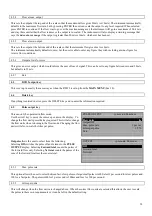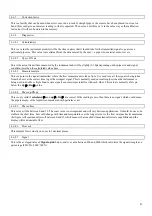
51
6.2.3
Transducer set "D"
The two 0.5 MHz transducer blocks are the same, there is no propagation rate measurement required when using transducer set
“D”.
5.
Strap the guide rail assembly to the pipe so that it is perfectly parallel to the pipe axis.
6.
When screwing the transducers on to the pipe surface use only enough force to ensure that the Transducer is flat against the
pipe surface and then lock in position.
7.
Clamping the transducers in exactly the correct position is extremely important. The Separation Distance is calculated by
the UFM 610 P and the transducers must be positioned and clamped exactly at the distance specified.
8.
Always use the couplant provided.
6.3
Liquid conditions
Transit time ultrasonic meters perform best on liquids that are totally free from entrained air and solids. With sufficient air in
the system the ultrasound beam can be attenuated totally and therefore prevent the instrument from working. Often it is possible
to tell whether there is air in the system or not. If a flow signal cannot be obtained a simple test to determine whether the flow is
aerated involves stopping the flow for a period of 10 - 15 minutes. During this time the air bubbles will rise to the top of the pipe
and the flow signal should return. If the flow signal does return switch on the flow and if sufficient entrained air is locked in the
system it will very quickly disperse and kill the signal.
6.4
Reynolds number
The UFM 610 P has been calibrated to operate on Turbulent flows with Reynolds No. of approximately 100,000.
When the Reynolds No. decreases to approximately 4000-5000 the instrument calibration is no longer valid. If the UFM 610 P
is to be used on laminar flow applications it will be necessary to calculate the Reynolds No. for each application. To calculate
the Reynolds No. it is necessary to know the Kinematic viscosity in Centistokes; the flow velocity and the pipe inside diameter.
To calculate
R
e
use the following formula:
R
dv
e
=
υ
1
7730
(
)
or
R
d v
e
=
1
1
1
1000
υ
(
)
Where
d
= inside pipe diameter in inches
v
1
= velocity in metres/second
d
1
= inside pipe diameter in millimetres
υ
1
= Kinematic viscosity in centistokes
v
= velocity in feet/second
To correct the UFM 610 P for operation in the laminar flow region, calculate the Reynolds No. and adjust the correction factor
as described on 4.6.7 - Options.
Couplant
Figure 22

























